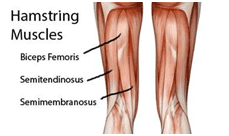
Rehabilitation for Hamstring muscle strain/tear; Is it safe to return to sport?
Hamstring muscle injuries are one of the most common sports injuries. These injuries often have long recovery times and can recur. You probably heard about these muscles all the time, but you may not fully understand where they are or what they do. In this week’s blog, we will unravel the mystery of your “tight” hamstrings, discover more about the types of hamstring injuries, Physiotherapy treatment and exercises to help with hamstring strain.
Understanding the hamstring muscles
The hamstring is a group of 3 muscles that run over the back of your thigh and cross over the hip and knee joints- biceps femoris, semitendinosus, semimembranosus. They allow you to bend your leg at the knee and help to extend your hip.

The hamstrings control the hip and knee joints utilizing two specific types of muscle contraction in everyday activities. The muscles contract in a way that the fibers shorten (concentric contraction) or lengthen (eccentric contraction) to generate force to move the joint or control the speed of the joint.
What is a strain / tear of the hamstring muscle and how does it affect you?
Hamstring injuries can range from mild to moderate to severe. They are usually classified into 3 grades:
- Grade 1 – mild muscle pull or strain
- Grade 2 – a partial muscle tear
- Grade 3 – a complete muscle tear
The recovery time from a hamstring strain/ tear will depend on how severe the injury is. A grade 1 hamstring strain may take a few days to heal, whereas more severe grades could take weeks or months to recover. In some cases it might even take up to a year before you can return to strenuous sports.
Hamstring injuries usually occur in conjunction with sudden, explosive movements, such as a sudden lunge, jump or sprint especially during activities like running, skating, tennis, basketball, soccer, dancing, and more. It can also happen if you overstretch them.
Common signs and symptoms include:
- sudden, sharp pain or tenderness at back of thigh
- a “popping” sensation at the time of injury
- swelling within the first few hours
- bruising within the first few days
- partial or complete weakness in your leg
- inability to place weight on your leg.
- Sudden and severe pain during exercise, along with a snapping or popping feeling
- Pain in the back of the thigh and lower buttock when walking, straightening the leg, or bending over
Musculoskeletal pain treatment for hamstring injuries
It can be quite a painful and debilitating experience if you have a hamstring injury. Physiotherapy intervention can help to address the acute symptoms, reduce pain and swelling through effleurage, electrical modalities, cryotherapy and home advice.
Once the acute symptoms have resolved the focus of the treatment will be regaining the range of motion and restoring the strength and endurance of the injured muscle. Rehabilitation exercises that incorporate a great deal of concentric and eccentric loading of the injured muscle tissue will be taught, followed by high speed resistive exercises and balance training in the later stage. These exercises help to progressively load the muscles, enabling the injured person to return to their pre-injury status.
Proper warm up and cool down exercises should be covered as well to prevent the recurrence of injury.
Exercise for hamstring muscle strain/tear (initial phase)
Double leg bridge- 3 sets of 10 reps
Standing leg lift – 3 sets of 10 reps
Prone leg curl- 3 sets of 10 reps
When can I return to sports?
Grade 1 or 2 tears or strains mostly heal within 3-8 weeks with diligent therapy whereas a grade 3 hamstrings tear or strain, recovery can be as long as 3-6 months. Keep in mind that people heal at different rates. It is not uncommon to deal with the symptoms for months and some studies indicate that the healing time can commonly extend beyond one year mark.
Without proper intervention, there’s a high chance for recurrence of the injury and you may develop permanent muscle dysfunction. Hence it is important to only return to a full level of activity when your hamstring muscles are strong enough to cope with your exercise intensity. Your Physiotherapist will be able to advise you about this.
Hamstring problems can be complicated to deal with. Our Physiotherapists are skilled at assessing your needs to create a tailored exercise program towards your treatment goals. For more information on Rehabilitation for Hamstring injuries, get in touch with us through our website www.rapidphysiocare.com or call +65 6904 4900.
Tags : Physiotherapy



